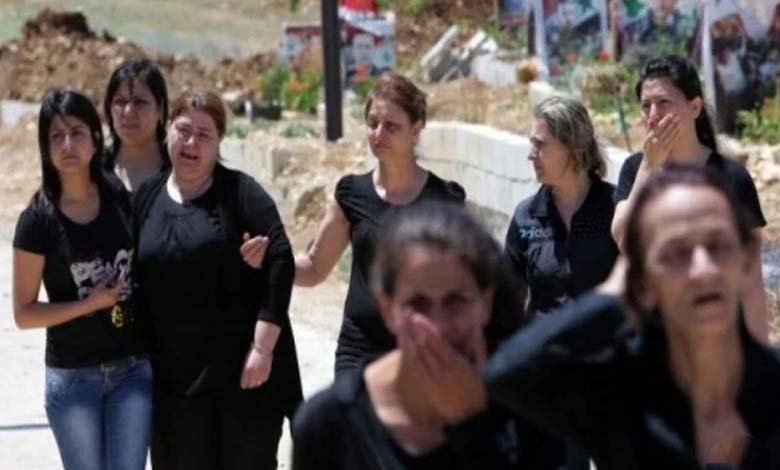Alaouite families haunted by daughters’ abductions amid lax government protection

Social media has seen a surge of messages and videos shared by families of missing Alawite women, pleading for any information about their loved ones.
“Don’t wait for her… your sister is not coming back.” That’s what a WhatsApp caller told the family of a woman named Abir on May 21, just hours after she vanished from the streets of Safita, Syria. She is one of dozens of Alawite women kidnapped without any serious effort by the new authorities to uncover their fate.
-
Alarming Resurgence of ISIS in Syria Following al-Assad’s Fall
-
Al-Assad Regime Remnants Seek to Return Syria to Chaos
Abir’s kidnapper and another man identifying himself as a negotiator later told the family she would be killed or sold into human trafficking unless a $15,000 ransom was paid.
On May 29, Abir herself called her family from the same Iraqi-numbered phone used by the kidnappers. “I’m not in Syria… the language around me is strange, I don’t understand anything,” she said.
Reuters reviewed the recorded call, along with around 12 other messages sent by the captors from both Iraqi and Syrian phone numbers.
-
Observatory: Widespread Field Executions of al-Assad Regime Members
-
Has Maher al-Assad Returned to Syria? Controversy and Official Response
Abir is among at least 33 Alawite women and girls aged 16 to 39 who have been abducted or gone missing this year, according to their families, amid the chaos that followed the ouster of former President Bashar al-Assad.
His fall in December, after a 14-year civil war, unleashed waves of violence against the Alawite minority he belonged to. Pro-government militias attacked Alawite civilians in coastal areas in March, killing hundreds.
Since March, social media has been flooded with videos and posts from desperate families seeking any trace of their daughters. New cases are reported almost daily.
-
Will al-Assad’s Regime Collapse Help ISIS Expand in Africa?
-
Europe and Syria After al-Assad: “A New Political Beginning”
The UN Commission of Inquiry on Syria confirmed it is investigating alleged disappearances and abductions of Alawite women following the spike in reports. A spokesperson said findings would be submitted to the UN Human Rights Council upon completion.
A relative of Abir said the family borrowed money from neighbors to gather the $15,000 ransom, transferring the funds to three different money transfer accounts in Izmir, Turkey, on May 27–28 through 30 transactions ranging from $300 to $700 each. He shared the receipts with Reuters. After the full amount was sent, the captors cut off communication. Abir’s fate remains unknown.
-
British Newspaper Reveals Attempt to assassinate al-Assad through Poisoning
-
Bashar Al-Assad: Details of the Final Days in Syria
Interviews with the families of 16 missing women revealed that seven were believed to have been abducted, with ransom demands ranging from $1,500 to $100,000. In three of these cases, including Abir’s, families received messages stating the women had been taken abroad.
No information is available for the remaining nine. Eight of the 16 were under 18.
All 33 women disappeared in Tartus, Latakia, and Hama — provinces with significant Alawite populations. About half have returned home, but none agreed to discuss what happened, citing security fears.
-
More than 7,000 Syrians in Jordan return to their country after al-Assad’s fall
-
Where Are Maher al-Assad and Ali Mamlouk Hiding? What Are Their Plans?
Most families told Reuters they felt local police did not take their cases seriously and that authorities failed to carry out proper investigations.
Ahmed Mohammad Khair, head of media relations in Tartus, denied the targeting of Alawites, claiming most disappearances were due to family disputes or personal reasons, not kidnappings, without providing evidence.
“Maybe she had issues with her family and ran away, maybe they were forcing her to marry someone she didn’t want,” he said. “Maybe she just wanted attention, or maybe she really was kidnapped.”
-
Key Leaders of the “al-Assad Regime”: Where Are They Now?
-
Decoys and Fake Helicopters: New Details Emerge About al-Assad’s Escape from Syria
He warned that spreading “unverified allegations” only sows panic and undermines local stability, especially in Tartus.
The media director in Latakia echoed these views, suggesting some women had run off with romantic partners, and their families fabricated kidnapping stories to avoid shame.
Syrian human rights activist Yamen Hussein, who tracks missing women, said most disappearances followed the March violence. He noted that only Alawite women appear to be targeted, with unknown perpetrators and motives.
-
Al-Assad Revealed Turkey’s Role in His Overthrow to Iran
-
Secret Turkish Deals with Russia and Iran Accelerated al-Assad’s fall
He described widespread fear among Alawites — a Shia sect comprising about 10% of Syria’s predominantly Sunni population. Girls in Tartus, Latakia, and Hama have been skipping school and university out of fear.
“There’s a clear pattern,” he said. “Alawite women disappear in broad daylight… targeting the defeated side’s women is a method of humiliation used by both the al-Assad regime and opposition forces in the past.”
-
Will the Arab Summit in Riyadh end al-Assad’s isolation?
-
Al-Assad in the first visit for the earthquake victims in Aleppo hospital
Thousands of Alawites have been displaced from their homes in Damascus, with some dismissed from their jobs or harassed at checkpoints by Sunni fighters affiliated with the government.
Interviews with the families of the missing women revealed that most were abducted in broad daylight while running errands or traveling by public transportation. The youngest was a girl named Zainab.
-
The fall of Al-Assad Sparks Political Debate in Iran
-
The fall of al-Assad’s Regime: Will It Affect Russia’s Influence in the Region?
A relative of 17-year-old Zainab said she was kidnapped on her way to school in the town of Al-Hanadi, Latakia, on February 27. He added that the suspected abductor used her phone to send a text message warning the family not to post her picture online.
The message read: “As I warned you, I don’t want to see any photo, or I swear to God I’ll send her back to you in her blood.”
-
After Al-Assad’s Fall… Syria Closes Its Doors to the Houthis
-
“Bashar al-Assad’s Fall: The Map of Armed Groups Under the Banner of ‘Hay’at Tahrir al-Sham’”
The relative said Zainab briefly called home, saying she didn’t know where she had been taken and that she was experiencing stomach pain, before the line cut off. Her family has no information about her whereabouts.
A relative of another woman, Khuzama, said she was abducted on March 18 in rural Hama by a group of five men who drugged her, causing her to lose consciousness for several hours during her abduction. The account is based on what Khuzama, a mother of five, shared after returning home.
-
Al-Assad’s Fall Weakens Iran but Doesn’t End Its Capabilities in the Middle East
-
Washington Warns al-Assad against Using Chemical Weapons in Response to His Defeats
The family member said 35-year-old Khuzama was held for 15 days, during which the kidnappers negotiated with the family. They eventually paid $1,500 to secure her release. Upon her return, she suffered a nervous breakdown.
A few days later, a relative of Douaa Abbas, 29, said a group abducted her from her doorstep, dragging her into a waiting car. The incident occurred in the town of Salhab, Hama province.
-
Syrian Kurds Plan to Empty Jihadist Camps by the End of the Year
-
Iran Plans to Restore Its Influence in Syria: Will It Use ISIS or Other Factions?
The relative, who did not see how many men were involved or whether they were armed, tried to follow them on his motorcycle, but the car disappeared quickly.
Three Alawite women reported missing this year later reappeared on social media and publicly denied being abducted. These three are not included in the count of 33.
-
Maher Al-Assad Abandons Hezbollah to Avoid Israeli Strikes
-
Public Opinion Expresses Rejection of International Intervention and Casts Doubt on al-Assad’s Involvement in Chemical Attack
One of them, a 16-year-old girl from Latakia, posted a video claiming she ran away voluntarily to marry a Sunni man. Her family disputed this, saying she was kidnapped and forced into the marriage, and that security officials instructed her to say she left willingly to protect her captors.
The two others — a 23-year-old woman and a 12-year-old girl — told Arab TV channels they traveled willingly to Aleppo and Damascus, respectively. The older woman later said she was beaten by a man in an apartment before escaping.
-
France Faces Backlash Over Arrest Warrant for al-Assad
-
The normalization with al-Assad fuels European disagreements
Alawites had long held top political and military positions under the Assad regime. The sudden fall of Bashar al-Assad in December brought a new government led by Hayat Tahrir al-Sham, a Sunni group formerly linked to Al-Qaeda.
The new authorities are struggling to incorporate fighters from dozens of former opposition factions — including foreign combatants — into their security forces, following the collapse of Assad‘s intelligence apparatus.
-
Syrian Coast Events: Commitment to “Accountability” and Arrest of Suspects
-
The Emir of the Turkestan Islamic Party Leads Fighters in Syria from Kabul… What’s the Story?
Several families of missing women say they fear a terrifying scenario in which Alawites could face a fate similar to that of the Yazidi minority under ISIS a decade ago.
According to the United Nations, ISIS enslaved thousands of Yazidi women during its reign of terror when it declared a caliphate over large swaths of Iraq and Syria.
-
The rejection of the two-state solution by the Israeli ambassador disappoints the British government
-
Following in the footsteps of the UAE, Egypt restores relations with Syria to end al-Assad’s international isolation
The family of Nagham Shadi, a recently disappeared Alawite woman, is gripped by fear. Her father said his 23-year-old daughter left their home in the village of Al-Bayyadiyya, Hama, on June 2 to buy milk and never returned.
He added that the family had fled their previous home in a nearby village on March 7 due to violence targeting Alawites. “What can we do?” he asked. “We leave it to God.”
-
Al-Assad meets Khamenei and Raisi in Teheran – Details
-
Turkey seeks to establish a base in Syria to monitor the Kurdish forces and Israeli influence
-
The U.S. Administration and Syria: Caution and Skepticism Towards the New Regime Led by Ahmad Al-Sharaa
-
The Fate of Syrian Officers in Iraq Depends on Agreements with Syria
-
Syria Accuses Hezbollah of Carrying Out Attacks and Sponsoring Cross-Border Smuggling
-
Al-Sharaa Pledges to Form an Inclusive Government in His First Speech to Syrians
-
Security Chaos Returns to Syrian Regions… Hayat Tahrir al-Cham Members Top the List of Accused
-
“The Passage is closed”: Syria Announces Interception of Weapons Bound for Hezbollah
-
U.S. Troop Reduction in Syria Puts SDF in Disarray
-
Where Are Syria’s Muslim Brotherhood Headed? And What Is al-Sharaa’s Position Toward the Group?
-
The Black Ghosts Strike: Is Russia Returning to Guerrilla Warfare Through Syria?
-
Has Maher al-Assad Returned to Syria? Controversy and Official Response
-
How ISIS Fighters in Northern Syria Could Benefit from Turkey’s Ambitions
-
Libyan Muslim Brotherhood Member Incites Armed Resistance Inspired by Syrian Factions
-
Al-Assad Regime Remnants Seek to Return Syria to Chaos
-
Hezbollah’s Violations Rekindle Tensions at the Syrian-Lebanese Border
-
ISIS Threatens al-Sharaa… Can the Group Still Operate in Syria?












